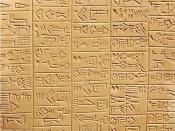As early as 3100 BCE, a detailed writing system appeared which allowed humans to record stories and life events in a permanent descriptive manner. This method, called Hieroglyphics, consisted of a series of simplified picture signs which represent objects, ideas, and eventually sound forms. It surpassed the communicative abilities of primitive art by allowing societies to create clear, precise, and uniquely retrievable records. By minimizing the reliance upon catechesis, or story telling, hieroglyphics has effectively contributed to our historical account of early civilizations and our understanding of how humanity was shaped.
The earliest known writing system appears to have been invented by the inhabitants of Uruk, one of the first great Mesopotamian cities. A series of pictographic symbols were carved into soft clay tablets and allowed to harden in the sun or fire kiln. The symbols represented rudimentary concrete objects, as well as concepts. Thus, a hand might represent both its superficial meaning of hand as well as the concepts of holding, grasping, or even creating (Cunningham & Reich 23).
As the system began to radiate into neighboring societies, it became even more expressive. Eventually, Sumerian pictorial signs "evolved into a series of wedge-shaped marks that were pressed in clay with a split reed" (Haviland 14). This cuneiform writing had an advantage as a quick and economical means of recording. However, the most fecund and expressive body of hieroglyphics - that utilized by the Egyptian civilization, maintained most of its pictographic roots. To accommodate an increasing demand for accuracy and specificity, Egyptian scribes began associating the objective meanings of ideograms with sounds [Fig. 1]. This adaptation lead to phonetic scripts which satisfied the necessity for recording personal and place names. The French historian, Jean-Francois Champollion was the first to decode Egyptian hieroglyphics according to their sound values (Edwards).
While the...


